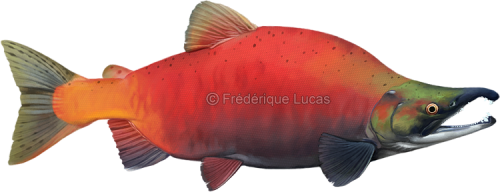#sea-run cutthroat
Strange salmon
So after the Pink salmon I promised some bonus fish, and here they are! These three were also featured on the poster. They’re all a bit unusual; they’re either a salmon but don’t behave like one, or vice versa. In order they are:
Steelhead (Oncorhynchus mykiss irideus)
Also known as: Rainbow, redband (trout)
Steelhead are the anadromous form of the Rainbow trout. Meaning they, just like salmon, live at sea but are born and return to spawn in freshwater. However, unlike salmon, they don’t die afterwards. After regaining their strength at sea they may return multiple times, and Steelhead as old as 11 years have been found spawning. Unlike regular rainbows these fish develop very salmon-like heads when spawning, with long faces and slight kypes. Their beautiful spotting is very fine and unusually regular on the tail. This unique patterning is always present and can be used to identify them even at sea. Thanks to the rich marine environment, Steelhead grow big: 48" (122 cm) and 55 lbs (25 kg) is maximum, but 20-30″ (50-75 cm) and 5-20 lbs (2.5-9 kg) average.
Coastal cutthroat trout (Oncorhynchus clarkii clarkii)
Also known as: Sea-run cutthroat, Harvest (trout)
Coastal cutthroat are the anadromous form of the regular Cutthroat trout. Unlike Steelhead and Pacific salmon, Cutthroat do not make lengthy migrations out to sea. Often they just hang out in estuaries for a few months, spending much of the rest of the year in freshwater. Not all upriver migrations are to spawn either; sometimes they just want to overwinter or feed. When fresh out of saltwater Cutthroat can be quite silvery, with pale throat slashes. But as they approach spawning they become more and more yellow and the slashes that give them their name more pronounced red. Coastal cutthroats don’t grow very big: 24″ (60 cm) and 8 lbs (3.5 kg) is the recorded maximum, but average is 10-16″ (25-40 cm) and 1-5 lbs (0.5-2 kg).
Kokanee salmon (Oncorhynchus nerka)
Also known as: Kennerly’s salmon/trout, Kokanee trout, Silver trout, Little redfish, Kikanning, Walla
Kokanees are the landlocked form of the Sockeye. Instead of venturing to sea, they spend most of their time in lakes, swimming upriver from them to spawn. Their pocket size and habitat should make identification easy enough. Interestingly, they often bear spots on their back and tail, something Sockeyes never have. The red on their gill covers can also be more extensive. The comparatively nutrient poor lake environment keeps Kokanees at an almost dwarf size compared to Sockeyes. Maximum size is 20″ (50 cm) and 6.25 lbs (3 kg), but don’t expect more than 9-12″ (23-30 cm) and 1-3 lbs (0.5-1 kg) on average.
Post link



